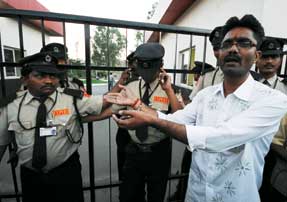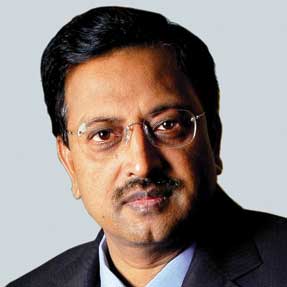Business
Scandal at Satyam: Truth, Lies and Corporate Governance

|
When terrorists attacked Mumbai last November, the media called it “India’s 9/11.” That tragedy has been succeeded by another that has been dubbed “India’s Enron.” In one of the the biggest frauds in India’s corporate history, B. Ramalinga Raju, founder and CEO of Satyam Computers, India’s fourth-largest IT services firm, announced on Jan. 7 that his company had been falsifying its accounts for years, overstating revenues and inflating profits by $1 billion. Ironically, Satyam means “truth” in Sanskrit, but Raju’s admission — accompanied by his resignation — shows the company had been feeding investors, shareholders, clients and employees a steady diet of asatyam (or untruth), at least regarding its financial performance.
Raju’s departure was followed by the resignation of Srinivas Vadlamani, Satyam’s chief financial officer and the government of India disbanded Satyam’s board. Meanwhile, a team of auditors from the Securities and Exchange Board of India (SEBI), which regulates Indian public companies, has begun an investigation into the fraud. Since Satyam’s stocks or American Depository Receipts (ADRs) are listed on the Bombay Stock Exchange as well as the New York Stock Exchange, international regulators could swing into action if they believe U.S. laws have been broken. At least two U.S. law firms have filed class-action lawsuits against Satyam, but given the company’s precarious finances, it is unclear how much money investors will be able to recover. According to experts, the Satyam debacle will have an enormous impact on India’s business scene over the coming months. The possible disappearance of a top IT services and outsourcing giant will reshape India’s IT landscape. Satyam could possibly be sold — in fact, it had engaged Merrill Lynch to explore “strategic options,” but the investment bank has withdrawn following the disclosure about the fraud. It is widely believed that rivals such as HCL, Wipro and TCS could cherry pick the best clients and employees, effectively hollowing out Satyam. Another possible impact could be on the trend of outsourcing to India, since India’s IT firms handle sensitive financial information for some of the world’s largest enterprises. The most significant questions, however, will be asked about corporate governance in India, and whether other companies could follow Satyam’s Raju in revealing skeletons in their own closets. ‘Riding a Tiger’
Raju was compelled to admit to the fraud following an aborted attempt to have Satyam invest $1.6 billion in Maytas Properties and Maytas Infrastructure (“Maytas” is Satyam spelled backwards) — two firms promoted and controlled by his family members. On Dec. 16, Satyam’s board cleared the investment, sparking a negative reaction by investors, who pummeled its stock on the New York Stock Exchange and Nasdaq. The board hurriedly reconvened the same day and called off the proposed investment. The matter didn’t die there, as Raju may have hoped. In the next 48 hours, resignations streamed in from Satyam’s non-executive director and Harvard professor of business administration Krishna Palepu and three independent directors — Mangalam Srinivasan, a management consultant and advisor to Harvard’s Kennedy School of Government; Vinod Dham, called the “father of the Pentium chip” and now executive managing director of NEA Indo-US Ventures in Santa Clara, Calif.; and M. Rammohan Rao, the dean of the Indian School of Business in Hyderabad (ISB). Resigning as Satyam’s chairman and CEO, Raju said in a letter addressed to his board, the stock exchanges and the market regulator Securities & Exchange Board of India (SEBI) that Satyam’s profits were inflated over several years to “unmanageable proportions” and that it was forced to carry more assets and resources than its real operations justified. He took sole responsibility for those acts. “It was like riding a tiger, not knowing how to get off without being eaten,” he said. “The aborted Maytas acquisition was the last attempt to fill the fictitious assets with real ones.” Specifically, Raju acknowledged that Satyam’s balance sheet included Rs. 7,136 crore (nearly $1.5 billion) in non-existent cash and bank balances, accrued interest and misstatements. It had also inflated its 2008 second quarter revenues by Rs. 588 crore ($122 million) to Rs. 2,700 crore ($563 million), and actual operating margins were less than a tenth of the stated Rs. 649 crore ($135 million). Satyam’s auditor PricewaterhouseCoopers issued a terse statement: “The audits were conducted by Price Waterhouse in accordance with applicable auditing standards and were supported by appropriate audit evidence. Given our obligations for client confidentiality, it is not possible for us to comment upon the alleged irregularities. Price Waterhouse will fully meet its obligations to cooperate with the regulators and others.” Impact on ‘Brand India’
The outrage over Raju’s admission of systematic accounting fraud has broadened to wider concern about the potential damage to India’s appeal for foreign investors and the IT services industry in particular. Immediately following Raju’s confession, Satyam’s shareholders took a direct hit as the company’s share price crashed 77% to Rs. 30 (approximately 60 cents), a far cry from its 52-week high of Rs. 544 ($11.35) last May. On the New York Stock Exchange, its price plummeted from a peak of $29.84 in the past year to 78 cents. “If there were one or two more such accounting scandals in the next six months, it would make international investors more wary,” says Wharton management professor Michael Useem. “One example would put people on guard; several examples would be enough to tell big investment money managers that they have to be especially careful working in that environment.” Jitendra Singh, currently dean of the Nanyang Business School in Singapore, believes Satyam is an “outlier” and that there is no reason to think that “problems of this kind may be much more extensive than one company or a handful of companies.” However, he adds, “foreign investors will look a little more askance at accounting data from India. And that may not be a bad thing.” Useem also warns against overreacting. “Don’t assume other firms are guilty,” he says. But he considers the situation to be an “alerting call” for investors to check where their money is, and for auditors and independent directors in all major firms to take a look at the books. Corporate India has tried to contain the damage so far. Rajeev Chandrasekhar, president of the Federation of Indian Chambers of Commerce and Industry, called upon regulators “to move quickly to demonstrate that this is an exceptional case among corporations, and that investors need not worry about Indian corporate governance and accounting standards.” Suresh Surana, founder of RSM Astute Consulting Group, said in a statement that the Satyam development is “a major eye opener and will bring into renewed and critical focus the role of independent directors, auditors, company management, [the] CFO and other key persons involved.” “When you have companies that are ostensibly growing their top lines at 30%, 40% or 50%, it is possible to paper over things,” Singh says. “Satyam was doing it by boosting sales and profits; Bernie Madoff was doing it by boosting rates of return. When growth rates slow down, you are unable to hide the financial reality of how much cash you actually have. It is possible that during this slowdown period, more scandals will come to light.” (U.S. financier Madoff last month admitted to running a $50 billion Ponzi scheme to keep his hedge fund afloat.)
Singh adds that companies with “the bluest of blue-chip reputations [such as] Infosys and TCS” could actually gain in the current environment, because of a potential “flight to quality” among client companies. “The third-tier and weaker companies will probably undergo a lot more scrutiny,” he says. According to Ravi Aron, senior fellow at the Mack Center for Technological Innovation at Wharton, the Satyam fallout could affect India’s IT offshoring and outsourcing firms in several ways. An immediate impact could be skepticism on the part of clients about whether Indian IT firms can be entrusted with sensitive financial information. “Clients could begin to ask, ‘How much do I know about this IT company and its governance?’” says Aron. “Is the IT service provider doing anything that could jeopardize the client’s compliance with FASB, Sarbanes Oxley, Basel II or other financial regulations?” Aron recommends that before other IT companies get blackballed because of Satyam’s problems, “they should act swiftly to demonstrate that their own operations are squeaky clean.” Indian IT companies have always had exceptionally high standards of accounting, and they should ensure that they do not face any spillover effect, he adds. This has already begun to happen. On the day that Raju came clean, N. R. Narayana Murthy, chief mentor at Infosys, was on Indian television — distancing Infosys and the rest of the IT industry from Satyam’s practices. Mauro Guillen, a Wharton management professor who has studied corporate governance in emerging economies, believes that Indian business has an advantage in arguing that the problem is limited to Satyam and is not systemic. “India is not perceived like Russia — it is neither everyone’s darling nor the plague,” he says. “This works to the country’s advantage because it deflects the blame of such occurrences to the way governance works in emerging economies rather than to India. What regulators in India need to do in response to Satyam is to find out quickly if other companies have been doing similar things. The proper response is to deal with and defuse the problem as soon as possible.” Guillen notes that what makes Satyam’s case unusual is that it had listed its ADRs on the NYSE. “Companies in emerging economies have trouble raising capital at low costs. The literature shows that is the reason they want to list in the U.S., where they accept a higher level of governance in order to raise capital at a lower cost. The fact that Satyam listed its ADRs in the U.S. but still had such serious governance problems makes this case particularly disturbing.” Guillen adds, though, that India has several well-regarded IT companies. “If one or two of them don’t make the grade, it should not shake investor confidence. It shows that investing in emerging markets is risky. Investors always balance risks and rewards. If the IT sector in India continues to remain competitive, the Satyam episode will just be a footnote in India’s business story. If the sector becomes uncompetitive, then that would create a serious problem.”
Saikat Chaudhuri, a management professor at Wharton, believes the Satyam episode reveals that the pressure on companies to maintain their financial performance is immense. “Satyam always wanted to keep up with the Big Three of Indian IT companies — TCS, Infosys and Wipro,” he notes. “At a time when the IT industry was booming and companies were growing rapidly, it was easy for Satyam to argue that the company was doing well and that it had good governance.” The involvement of the board, Chaudhuri adds, was at the “strategic level; in companies like Satyam, it is the owner/promoter/founder who runs the show. It has to do with the ownership structure.” In Chaudhuri’s view, auditors such as PricewaterhouseCoopers, who signed off on the bogus accounts at Satyam, have a lot more to answer for than the board of directors. “This is a serious lapse on their part. They should have probed.” Chaudhuri’s advice to other Indian IT firms is to distance themselves from the Satyam fallout through prompt action. “Honesty and transparency will alleviate investor concerns,” he says. “I don’t believe the sector will come crashing down. Perhaps Indian IT companies will face more scrutiny in the coming months; they may have to answer a few more questions, but India Inc. will pull through.” NASSCOM, the National Association of Software and Services Companies, could play a role in helping communicate that “the Satyam episode, though it shocked everyone, is an isolated instance,” he adds. Useem says that if one were to take an inference from recent high-profile scandals outside of India, “there would be a redoubled effort [in India] on the part of investors and independent directors at other companies to ensure that nothing like what happened at Satyam happens under their noses.” Singh says that the Satyam scandal doesn’t necessarily warrant more regulation. “There is no need to strengthen corporate governance regulations [in India],” he says. “The issue is really more one of leadership at the board level. The tone gets set by the chairman of the board; it’s much more a matter of culture within the board room, of the group dynamics within the board.” Truth in Numbers Notwithstanding Raju’s confession, the Satyam episode has brought into sharp relief the role and efficacy of independent directors. SEBI requires Indian publicly held companies to ensure that independent directors make up at least half their board strength. The knowledge available to independent directors and even audit committee members is inherently limited to prevent willful withholding of crucial information, Singh notes. “The reality is, at the end of the day, even as an audit committee member or as an independent director, I would have to rely on what the management was presenting to me,” he says, drawing upon his experience as an independent director and audit committee member at Fedders, a publicly held company in the U.S. that filed for bankruptcy last year. “It is the auditors’ job to see if the numbers presented are accurate.” Singh says he drew “a level of confidence” from the accounting rigor and governance mechanisms at Infosys, where he was an independent director from 2000 to 2003. He recalls how T.V. Mohandas Pai, the company’s then-chief financial officer (now a director overseeing human resources) “would take so much time going into accounting details.” Even if outside directors were unaware of the true state of Satyam’s finances, some red flags should have been obvious. According to Aron, Satyam is one of the world’s largest implementers of SAP systems. In an effort to compete against Satyam, HCL recently acquired Axon, an SAP consulting firm, at a cost of $800 million. Aron notes that any Satyam director should have been puzzled that the company was proposing to invest $1.6 billion in real estate at a time when a competitor as formidable as HCL was gunning for one of its most lucrative markets. “IT is a highly capital-intensive business, especially in India,” says Aron. “What on earth would compel Satyam to invest $1.6 billion in real estate at a time when competition with HCL was about to grow more intense? That is what the directors should have been asking.” Instead, he adds, like the dog that didn’t bark in the Sherlock Holmes story, the matter was allowed to slide. How effective independent directors can be is mainly a factor of the “dynamics inside the board room once the doors are closed,” according to Singh. “There is an attitude in some Indian companies that the board members actually work for the people who have brought them onto the board. This is a completely misguided attitude. It looks like this may have been a problem at Satyam…. The real strength of a healthy board is when a consensus gets overturned by a dissenting view.” Even if the proposed investment in the two Maytas firms appeared to be ethical on first sight, Singh notes that he would have expected the independent directors to be extra careful. “Given the fact that there is a family connection involved, as an independent board member I would be looking very hard at whether this is the right decision for the company,” he says. “Also, quite aside from issues of governance, everything we know about unrelated diversification [deals] from management literature is that, as a general matter, they are not a good idea; they don’t seem to make strategic sense.” Independent Defectors Useem wonders if the Satyam directors who resigned actually did the right thing. “The leadership dictum is that you need to stay the course, stay in the game, face the problem and solve the problem,” he says. “Did the four directors who resigned have an option of banding together, staying on the board and changing governance?” Useem adds that “it is often very hard to stay the course. I am empathetic with people who have difficulty [making that decision].” In a written response, Palepu, Satyam’s former non-executive director, stated that he was not present at the board meetings where the Maytas investment proposals were discussed. “As a result, under Indian law, I was not eligible to vote on the proposals,” he said. Palepu earned nearly Rs. 1 crore (about $200,000) from Satyam in 2007, according to regulatory filings, most of it for rendering “professional services.” He declined comment, but those services were essentially leadership development and consulting for Satyam’s top management, according to Archana Muthappa, the company’s head of media relations. SEBI and India’s registrar of companies have launched an investigation into Satyam. Singh says it is important to remember who the ultimate victims are in cases like Satyam. “This is a real tragedy; the people who will be left holding the bag will be the shareholders.” Even as Raju is widely blamed for unleashing “India’s Enron,” Chaudhuri points to a major difference between Enron and Satyam. “At Enron, the CEO stonewalled, while whistle-blowers came out with the truth,” he says. “At Satyam, there were no whistle-blowers. The CEO blew the whistle on himself.” In that sense, Raju did — ultimately — tell the truth and perhaps live up to the “Satyam” name. Unfortunately for him, the company, and India’s IT industry, by then it was much too late.
|






You must be logged in to post a comment Login